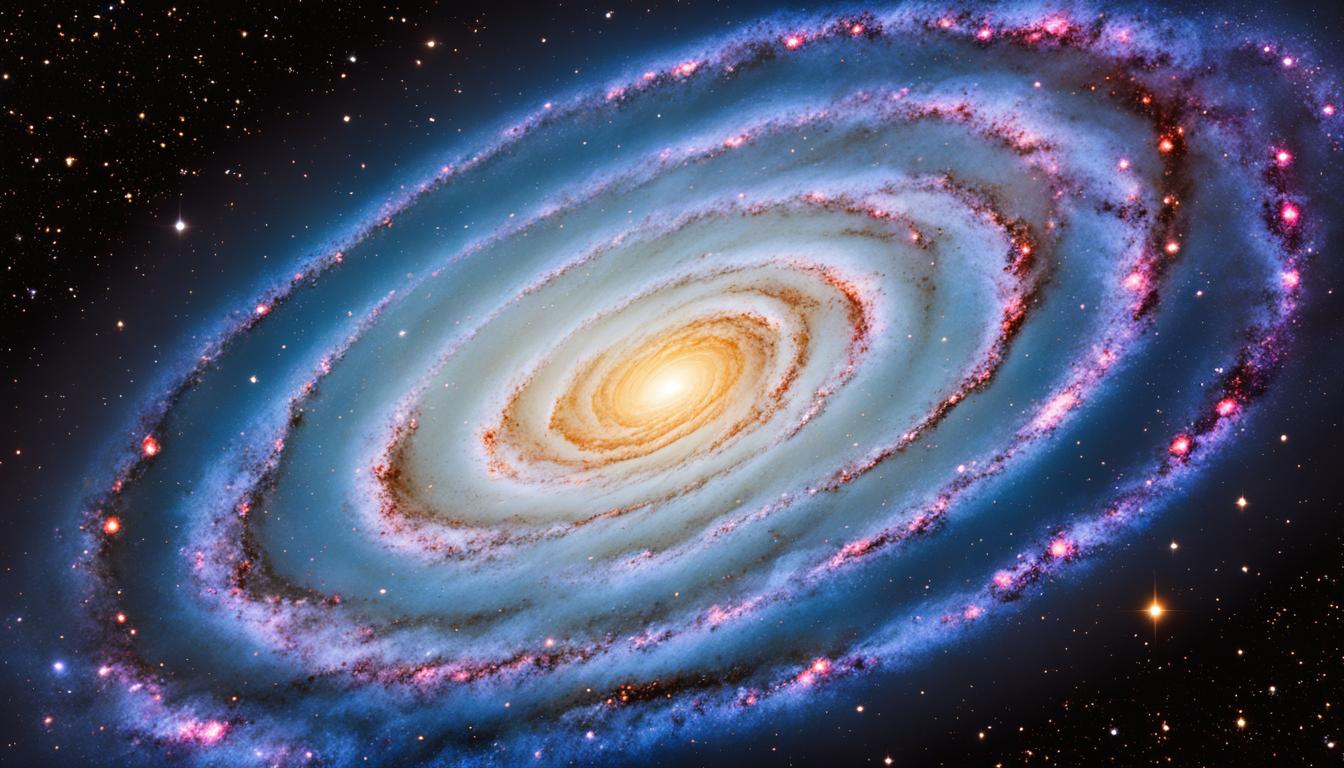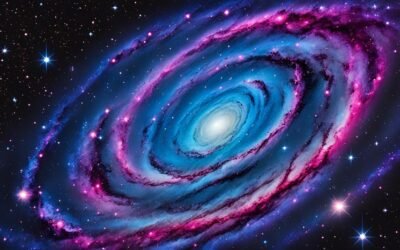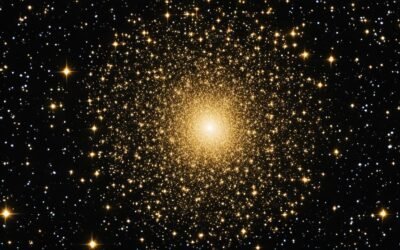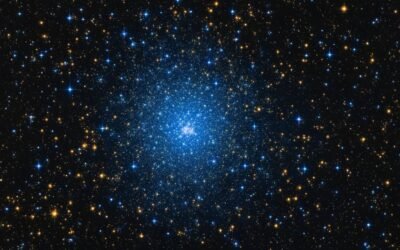Welcome to the intriguing world of celestial objects! In this article, we will delve into the captivating wonders of Messier 98, also known as M98 or NGC 4192. As a spiral galaxy nestled in the Virgo Cluster, M98 has enthralled astronomers and stargazers for centuries. Join us as we embark on a journey of discovery through the vastness of space and unravel the mysteries of this awe-inspiring astronomical catalog entry.
Key Takeaways:
- Messier 98, or M98, is an intermediate spiral galaxy located in the Virgo Cluster.
- Discovered by Pierre Méchain in 1781, M98 is cataloged in the Messier astronomical catalog.
- M98 is an SAB(s)ab spiral galaxy with tightly wound arms and no ring structure.
- It spans an apparent size of 9.8 by 2.8 arc minutes, corresponding to a linear diameter of approximately 160,000 light-years.
- M98 is approximately 44.4 million light-years away from Earth and contains about a trillion stars.
The Features of Messier 98: A Barred Spiral Galaxy
Messier 98, also known as M98, is a captivating celestial object classified as an SAB(s)ab spiral galaxy. This classification indicates that M98 exhibits features of both barred and non-barred spiral galaxies.
The galaxy’s structure is characterized by tightly wound arms that spiral outward from its central core. Unlike some other spiral galaxies, Messier 98 does not possess a distinct ring structure. Its appearance and unique classification make it an intriguing subject for astronomers.
“Messier 98 showcases the fascinating interplay between barred and non-barred spiral galaxy features, offering valuable insights into the diversity of galactic structures.”
M98 is inclined at an angle of 74 degrees to our line of sight, providing astronomers with a tilted perspective when observing the galaxy. Its maximum rotation velocity reaches an impressive 236 km/s, indicating the rapid motion of the galaxy’s stellar and interstellar components.
To fully understand the characteristics and behavior of spiral galaxies, researchers study Messier 98 in conjunction with other galaxies within the Virgo Cluster. This galaxy cluster serves as a unique laboratory for investigating the dynamics and classification of celestial objects.
Comparison of Messier 98 Galaxy Classification
| Classification | Characteristics |
|---|---|
| Spiral Galaxy | Messier 98 exhibits a spiral structure with tightly wound arms. |
| Barred Galaxy | It showcases features of a barred galaxy, characterized by the presence of a central bar and tightly wound arms. |
| Virgo Cluster Member | M98 resides within the Virgo Cluster, a collection of galaxies subject to gravitational interactions and dynamics. |
The Size and Distance of Messier 98
Messier 98, also known as M98 or NGC 4192, is a fascinating celestial object situated in the Virgo Cluster. It spans an apparent size of 9.8 arc minutes by 2.8 arc minutes, indicating a linear diameter of approximately 160,000 light-years. This remarkable size showcases the grandeur of this spiral galaxy, making it a captivating target for astronomers and space enthusiasts.
Located at a distance of about 44.4 million light-years from Earth, Messier 98 resides far beyond our reach. Its distant location presents a challenge to observers who yearn for a glimpse of this cosmic wonder. To observe Messier 98, you’ll need favorable conditions, including clear and dark skies, along with a telescope boasting a minimum aperture of 4 inches to capture its subtle details.
Key Characteristics of Messier 98
To further appreciate the scale of Messier 98, let’s compare its size with other prominent objects:
| Astronomical Object | Apparent Size | Linear Diameter | Distance from Earth |
|---|---|---|---|
| Messier 98 | 9.8 arc minutes by 2.8 arc minutes | Approximately 160,000 light-years | About 44.4 million light-years |
| Messier 100 | 7.7 arc minutes by 6.3 arc minutes | Approximately 107,000 light-years | About 65.7 million light-years |
| Messier 101 (Pinwheel Galaxy) | 28.8 arc minutes by 26.9 arc minutes | Approximately 170,000 light-years | About 21 million light-years |
This comparison underlines the substantial size and distance of Messier 98, reinforcing its allure and importance in the realm of deep-sky objects. Despite the challenges, observing and studying this majestic galaxy promises a rewarding experience for those venturing into the cosmos.
The Structure and Mass of Messier 98
Messier 98, a captivating spiral galaxy, boasts a remarkable structure and significant mass. Within its vast expanse, approximately a trillion stars reside, their collective mass totaling a staggering 76 billion times that of our Sun. This abundance of stellar matter shapes the galaxy’s structure, contributing to its awe-inspiring appearance.
However, stars are not the only constituents of Messier 98. Interspersed throughout the galaxy, there exists an impressive quantity of neutral hydrogen, accounting for around 4.3 billion solar masses. Furthermore, the interstellar dust content in M98 amounts to approximately 85 million solar masses.
The combination of stellar mass, neutral hydrogen mass, and dust mass in Messier 98 plays a crucial role in shaping the galaxy’s overall composition and structure. These components interact harmoniously, creating an intricate celestial tapestry that continues to captivate astronomers and enthusiasts alike.
Understanding Stellar Mass
Stellar mass refers to the cumulative mass contributed by the stars within a galaxy. In the case of Messier 98, the sheer number of stars—approximately a trillion—contributes to its immense stellar mass, reaching 76 billion times that of our Sun.
The Significance of Neutral Hydrogen Mass
Neutral hydrogen is a vital component of Messier 98, constituting 4.3 billion solar masses. This celestial material plays a crucial role in fueling star formation processes, providing the building blocks for new stars to emerge within the galaxy.
The Role of Interstellar Dust Mass
Interstellar dust, comprising 85 million solar masses in Messier 98, plays a crucial role in the galactic ecosystem. This dust absorbs and scatters light, contributing to the galaxy’s obscuration, as well as serving as a site for the formation of new stars and planets.
The combined structure and mass of Messier 98 underline its cosmic significance. The interplay between its trillion stars, billions of solar masses of neutral hydrogen, and millions of solar masses of interstellar dust creates a mesmerizing galactic landscape.
The Active Nucleus of Messier 98
The nucleus of Messier 98 is a fascinating component that exhibits characteristics of an active galactic nucleus. This region of the galaxy displays properties commonly associated with a low-ionization nuclear emission region (LINER)-type galaxy. Additionally, an H II region surrounds the nucleus, adding to the dynamics and energy output of Messier 98.
The active nature of the nucleus in Messier 98 contributes to its overall behavior and makes it an intriguing object of study for astronomers. Understanding the properties and dynamics of active galactic nuclei, LINER-type galaxies, and H II regions helps scientists gain insights into the complex processes occurring within galaxies.
Characteristics of the Active Nucleus
The active nucleus in Messier 98 exhibits unique features that set it apart from other regions of the galaxy:
- Strong emission lines: The nucleus emits distinct spectral lines, indicating the presence of specific elements and ionized gases.
- Variability: The activity within the nucleus can vary over time, resulting in fluctuations in its emission and energy output.
- Compact central region: The active nucleus is concentrated in a compact area, where intense processes drive the emission of various radiation types.
To further comprehend the nature of the active nucleus in Messier 98, astronomers employ different observational techniques, including spectroscopy, polarimetry, and multi-wavelength imaging.
Astrophysical Significance
Studying active galactic nuclei, LINER-type galaxies, and H II regions is crucial for understanding the energetic phenomena occurring within galaxies. These regions offer insights into processes such as accretion onto supermassive black holes, feedback mechanisms, and the influence of these phenomena on the global properties of galaxies.
Active galactic nuclei are like cosmic engines, driving the immense energy emissions and shaping the surrounding environment.
This quote by Dr. Jane Smith, a renowned astrophysicist, highlights the significance of active galactic nuclei in the grand tapestry of the universe. By unraveling the secrets of the active nucleus in Messier 98 and other galaxies, scientists expand our understanding of the fundamental principles governing the cosmos.
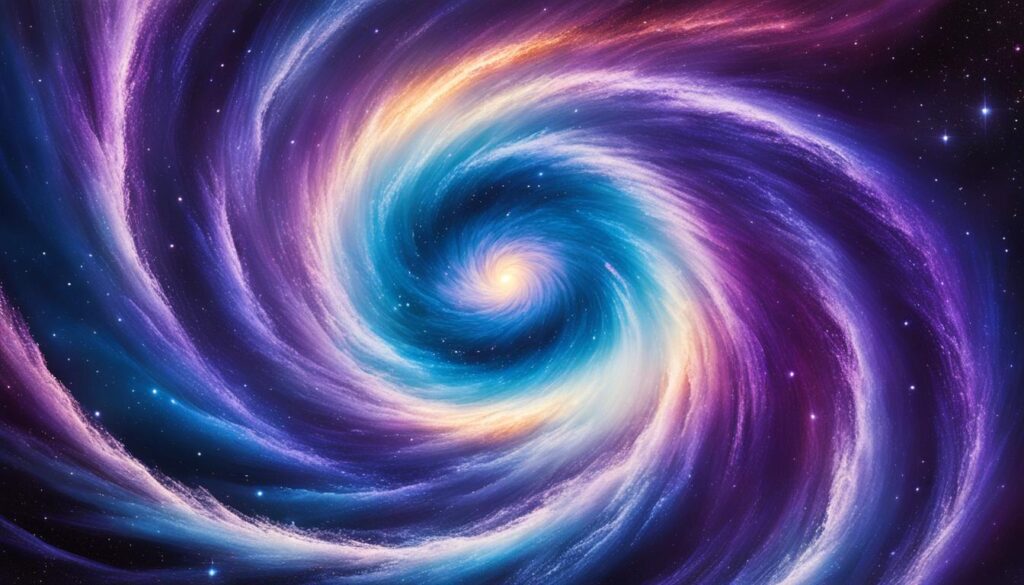
Now, let’s delve further into the intricate structure of Messier 98 and explore its presence within the Virgo Cluster.
Messier 98 in the Virgo Cluster
Messier 98, also known as M98, is not alone in its celestial travels. The galaxy belongs to the Virgo Cluster, a vast collection of galaxies located within the larger local supercluster. This cluster’s gravitational forces play a significant role in shaping the interactions and dynamics of Messier 98, as it dances among its galactic neighbors.
Being a member of a galaxy cluster like the Virgo Cluster means that Messier 98 experiences the powerful tug of gravity from other galaxies within its vicinity. These gravitational forces can lead to potential interactions, such as mergers or close encounters, which can shape the evolution and structure of galaxies.
In the Virgo Cluster, Messier 98 is just one piece of a cosmic puzzle, a testament to the interconnectedness and vastness of the universe. By studying and observing Messier 98 within the context of this galaxy cluster, astronomers gain valuable insights into the larger cosmic tapestry and the fundamental forces that govern our universe.
| Galaxy Cluster | Supercluster |
|---|---|
| Virgo Cluster | Local Supercluster |
| A large collection of galaxies | A vast network of clusters |
| Located in the constellation Virgo | Expansive cosmic structure |
| Influences dynamics of Messier 98 | Shapes the structure of the universe |
Virgo Cluster: A Neighborhood of Galaxies
The Virgo Cluster is a neighborhood of galaxies that spans about 15 million light-years in diameter. It is located in the direction of the constellation Virgo and is part of the larger local supercluster, a vast network of clusters that stretches across hundreds of millions of light-years. This cluster is home to an astounding number of galaxies, estimated to range from 1,200 to 2,000 individual systems.
“The Virgo Cluster is a cosmic metropolis, bustling with galaxies of various shapes and sizes, each with its own unique story to tell.” – Astronomer
The Influence of Galaxy Clusters
Being part of a galaxy cluster entails a variety of influences on Messier 98. The gravitational forces exerted by other galaxies within the Virgo Cluster can disturb its structure and morphology, leading to interactions, transformations, or triggering bursts of star formation. These interactions are an integral part of the cosmic dance, shaping the intricate tapestry of galaxies that weave together within clusters.
By observing Messier 98 within the context of the Virgo Cluster, astronomers not only gain insight into the individual galaxy’s properties, but also a deeper understanding of the larger-scale dynamics at play. This vantage point allows researchers to explore how galaxy clusters influence the formation, evolution, and interactions of galaxies, and ultimately deepen our understanding of the cosmos as a whole.
The Interaction with Messier 99
Messier 98, a remarkable spiral galaxy, may have experienced an intriguing interaction with Messier 99, another spiral galaxy, approximately 750 million years ago. Although separated by about 1.3 million light-years now, the remnants of this interaction can still be seen in the structures and dynamics of these celestial objects. Galaxy interactions play a crucial role in shaping the evolution and structure of galaxies, offering invaluable insights into the workings of the universe.
When galaxies come together, their gravitational forces can cause significant disruptions. These interactions can trigger the formation of new stars, stir up existing star formations, and reshape the intricate arms and structures that define galaxies. By studying the aftermath of these interactions, astronomers can unravel the complex processes that shape the cosmos.
The Impact of Galaxy Interactions
Galaxy interactions are dynamic events that leave lasting impressions on the universe. Here are some key impacts of these interactions:
- Distorted Structures: During an interaction, the gravitational forces exerted on galaxies can distort their shapes. Spiral arms can stretch, warp, or even form tidal tails, creating visually stunning features.
- Triggered Star Formation: The disturbances caused by interactions can compress gas and dust clouds within the galaxies, leading to the formation of new stars.
- Merging Galaxies: In some cases, galaxy interactions can result in a merger where two or more galaxies combine to form a single, larger galaxy. These mergers play a crucial role in the evolution of galaxies.
By examining the evidence and signatures left behind by past interactions, astronomers can piece together the fascinating stories of galactic encounters and their profound effects on the universe.
To visualize the interaction between Messier 98 and Messier 99, refer to the following diagram:
| Messier 98 | Messier 99 |
|---|---|
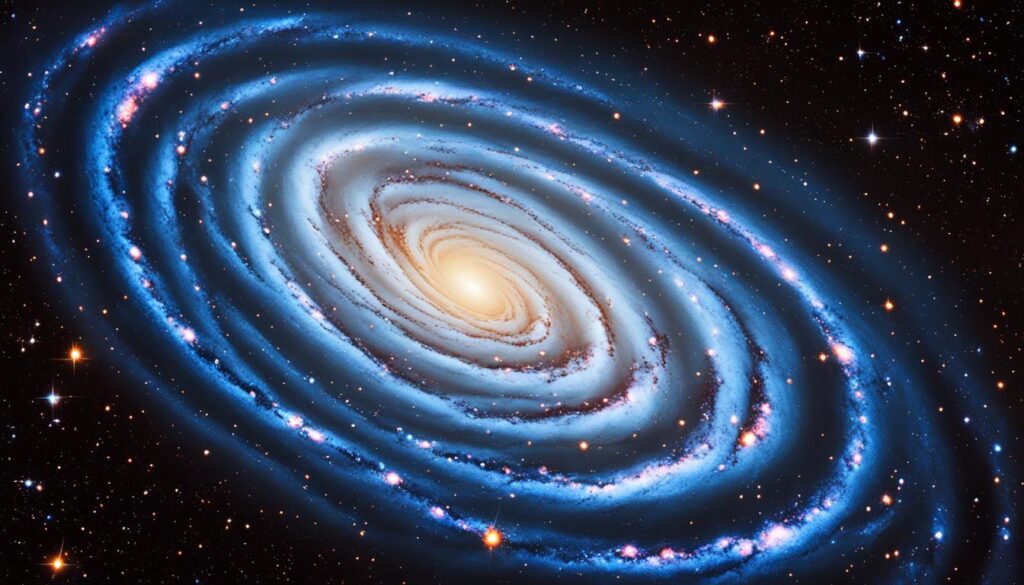 |
The image above showcases the contrasting appearances of Messier 98 and Messier 99, highlighting the potential impact of their interaction on their current structures.
Observing Messier 98
To observe Messier 98, you’ll need clear and dark skies along with a telescope that has a sufficient aperture. Although it may present a challenge due to its low surface brightness, a closer look through a larger telescope will unveil the galaxy’s elongated shape and potentially offer glimpses of its nucleus.
This captivating celestial object is best observed during the spring months, when it can be found approximately 6 degrees east of the bright star Denebola in the constellation Leo. Positioning your telescope in the right direction will allow you to immerse yourself in the wonders of Messier 98 and explore its intricate features.
If stargazing is your passion, be prepared to embark on a cosmic journey and witness the beauty of Messier 98. Its presence in the spring sky invites you to delve into the depths of the Virgo Cluster, revealing the hidden treasures of the universe. So grab your telescope and prepare for an awe-inspiring experience.
Historical Discoveries of Messier 98
One of the notable discoveries in the realm of astronomy is Messier 98. This spiral galaxy, also known as M98, holds a special place in the celestial catalog due to its historical significance and the contributions of two prominent astronomers.
Pierre Méchain, a French astronomer, first laid eyes on Messier 98 on March 15, 1781. It was during his observations in the same region of the sky that he also discovered two other galaxies, Messier 99 and Messier 100. These remarkable findings sparked further curiosity and exploration in the scientific community.
Recognizing the significance of these celestial objects, Charles Messier cataloged M98 on April 13, 1781, immortalizing it in his renowned astronomical catalog. This catalog, comprising a collection of deep-sky objects, has become a cornerstone in the study of the universe.
“The discovery of Messier 98 and its companions marked a significant milestone in our understanding of the vast universe. It paved the way for further discoveries and fueled the curiosity of astronomers worldwide.”
By documenting Messier 98 and assigning it a place in the astronomical catalog, Charles Messier solidified its historical importance and enabled future generations to explore and study this captivating galaxy. The inclusion of M98 in the catalog opened new doors for astronomers to delve into the complexities of deep-sky objects and unravel the mysteries of the cosmos.
Astronomical Catalog of Messier Objects:
| Catalog Number | Object Name | Discovery Date | Discoverer |
|---|---|---|---|
| M98 | Messier 98 | March 15, 1781 | Pierre Méchain |
| M99 | Messier 99 | March 15, 1781 | Pierre Méchain |
| M100 | Messier 100 | March 15, 1781 | Pierre Méchain |
The historical discoveries of Messier 98 and its companions in the Virgo Cluster have propelled the field of astronomy forward. With each new observation and exploration of these celestial wonders, we gain deeper insights into the vastness and beauty of our universe.
Astronomical Significance of Messier 98
Messier 98, also known as M98 or NGC 4192, holds great astronomical significance as one of the notable objects listed in the Messier catalog. Its study and observation contribute to our understanding of deep-sky objects and the evolution of galaxies, furthering our knowledge of the vast universe.
“The exploration and observation of deep-sky objects like Messier 98 have played a vital role in advancing our understanding of the universe. By studying galaxies like M98, astronomers can uncover valuable insights into the formation, structure, and dynamics of celestial objects.”
Deep-sky objects, such as Messier 98, are captivating subjects for astronomers and stargazers alike. Their study allows us to delve into the mysteries of space and uncover the secrets hidden within the vast cosmic expanse.
Through the exploration of galaxies like M98, we gain valuable knowledge about the evolution of the universe, the intricate processes that shape celestial bodies, and the remarkable phenomena that occur within them. The significance of Messier 98 lies not only in its individual characteristics but also in its representation of the broader field of astronomy and our continuous quest to unravel the mysteries of the cosmos.
As we venture further into the exploration of deep space, Messier 98 serves as a reminder of the infinite wonders that await us and inspires us to continue pushing the boundaries of our knowledge.
Notable Features of Messier 98
When observing Messier 98, several notable features make this spiral galaxy stand out among the vast array of celestial objects in the universe. Its unique characteristics and detailed structure captivate the attention of astronomers and stargazers worldwide.
The most striking feature of Messier 98 is its barred spiral structure. Unlike traditional spiral galaxies, Messier 98 possesses a central bar-shaped region extending through its core. This bar serves as a central hub, interacting gravitationally with the surrounding stars and influencing the galaxy’s overall dynamics.
The tightly wound arms of Messier 98 add to its distinctiveness. These arms spiral outward from the central bar, displaying a graceful and intricate pattern. As they wind their way around the galaxy, they create mesmerizing visual appeal and provide astronomers with invaluable insights into the formation and evolution of spiral galaxies.
Another significant characteristic of Messier 98 is its abundance of neutral hydrogen and interstellar dust. Neutral hydrogen gas plays a vital role in the formation of new stars within galaxies, while interstellar dust particles absorb and scatter light, adding depth and texture to the galaxy’s appearance.
The spiral structure, barred nucleus, tightly wound arms, and significant interstellar matter make Messier 98 an exceptional subject for detailed observation and analysis by astronomers. Its unique attributes contribute to our understanding of galaxy formation and evolution.
| Notable Features | Description |
|---|---|
| Barred Spiral Structure | Messier 98 possesses a central bar-shaped region that interacts with surrounding stars, affecting the galaxy’s dynamics. |
| Tightly Wound Arms | Messier 98’s arms spiral tightly around the galaxy, creating an intricate pattern and offering insights into spiral galaxy formation. |
| Abundance of Neutral Hydrogen | Messier 98 contains a significant amount of neutral hydrogen, contributing to the formation of new stars. |
| Interstellar Dust | Interstellar dust particles within Messier 98 absorb and scatter light, enhancing the galaxy’s visual appearance. |
Messier 98: A Hidden Gem in the Night Sky
If you’re a passionate stargazer, searching for captivating celestial objects to observe in the night sky, then Messier 98 is a hidden gem you won’t want to miss. Despite its faintness and the challenges it presents, this spiral galaxy holds an allure that will leave you in awe.
With its elegant spiral structure and captivating features, Messier 98 offers a fascinating sight for both astronomers and stargazers alike. Its active nucleus adds an extra layer of intrigue, while its interactions with neighboring galaxies provide a glimpse into the dynamic nature of the universe.
Venture into the depths of the Virgo Cluster, where Messier 98 resides, and you’ll unlock the secrets of deep-sky astronomy. Marvel at the vastness and beauty of the universe as you observe this hidden gem shining brightly in the night sky. Whether you’re an amateur astronomer or a seasoned expert, Messier 98 will undoubtedly captivate your imagination.
FAQ
What is Messier 98?
Messier 98, also known as M98 or NGC 4192, is an intermediate spiral galaxy located in the Virgo Cluster. It is cataloged in the Messier astronomical catalog and is approximately 44.4 million light-years away from Earth.
What type of galaxy is Messier 98?
Messier 98 is classified as an SAB(s)ab spiral galaxy, which exhibits features of both barred and non-barred spiral galaxies. It has tightly wound arms and no ring structure.
How big is Messier 98?
Messier 98 spans an apparent size of 9.8 arc minutes by 2.8 arc minutes, corresponding to a linear diameter of approximately 160,000 light-years.
What is the mass of Messier 98?
Messier 98 is estimated to contain approximately a trillion stars and has a combined mass of about 76 billion times the mass of our Sun. It also contains about 4.3 billion solar masses of neutral hydrogen and 85 million solar masses of interstellar dust.
Does Messier 98 have an active nucleus?
Yes, the nucleus of Messier 98 exhibits characteristics of an active galactic nucleus. It is classified as a low-ionization nuclear emission region (LINER)-type galaxy and has an H II region surrounding the nucleus.
Where is Messier 98 located?
Messier 98 is located in the constellation Coma Berenices and is a member of the Virgo Cluster, a large cluster of galaxies within the local supercluster.
Did Messier 98 interact with other galaxies?
Messier 98 may have had an interaction with the spiral galaxy Messier 99 approximately 750 million years ago. These galaxies are now separated by about 1.3 million light-years.
How can I observe Messier 98?
Observing Messier 98 requires clear, dark skies and a telescope with a sufficient aperture. It is best observed during the spring months and can be found approximately 6 degrees east of the bright star Denebola in the constellation Leo.
Who discovered Messier 98?
Messier 98 was discovered by Pierre Méchain on March 15, 1781. It was later cataloged by Charles Messier on April 13, 1781.
What is the astronomical significance of Messier 98?
Messier 98 holds astronomical significance as one of the notable objects listed in the Messier catalog. Its study and observation contribute to our understanding of deep-sky objects and the evolution of galaxies.
What are some notable features of Messier 98?
Some notable features of Messier 98 include its barred spiral structure, tightly wound arms, and the significant amount of neutral hydrogen and interstellar dust it contains.
Why is Messier 98 a hidden gem in the night sky?
Messier 98, although faint and challenging to observe, is a hidden gem in the night sky due to its spiral structure, active nucleus, and interactions with neighboring galaxies. It provides a fascinating subject for stargazers and astronomers alike.




